Arsenal – Manchester City 2:1
Arsenal beat Manchester City in this potentially title-deciding battle at the Emirates. Wenger’s side were creative and fluid in attack and surprisingly resolute in defence and although they had less possession and fewer shots, were the better side on the night.
The most significant line-up news was surrounding two South American forwards. Sergio Aguero was returning from injury Manchester City and put in a typical Aguero-coming-back-from-injury performance (cautious and harmless). Meanwhile, to Raymond Verheijen’s delight I would imagine, Alexis Sanchez wasn’t risked despite being expected to return from a hamstring injury.
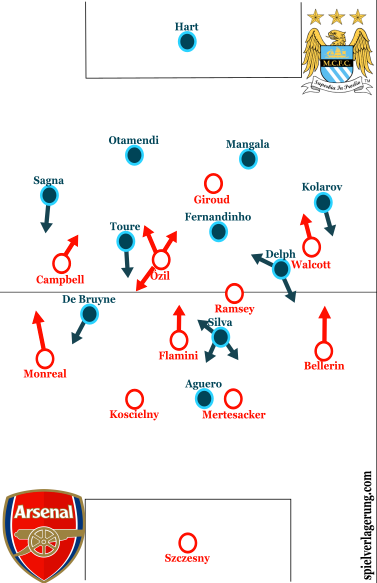
The starting XIs. Arsenal would be described as a 4-2-3-1 with possession however a 4-1-4-1 or 4-5-1 when defending in their own half. Manchester City played in a 4-4-1-1 formation with Delph playing narrower and deeper than De Bruyne and Silva roaming.
Arsenal’s Defending-Better In Their Own Half Than In The Opposition’s.
Pressing in the final third
As Arsene Wenger suggested in his pre-game press conference, Arsenal did apply pressure to the ball and have a high block when City were building up in the first third. Özil often moved up next to Giroud to press the centre-backs and Ramsey and Flamini stuck tight to Toure and Fernandinho. The pressing worked with mixed success with Giroud’s pressure on Managala causing him to misplace a pass to Fernandinho, allowing Arsenal to recover possession and score. However, it sometimes was too uncoordinated and structurally flawed as shown below.
Otamendi has already had time to take a touch and is being pressed by Giroud. Ramsey, Flamini, Monreal and Walcott are fairly static. They aren’t pressing anybody, closing important space nor deliberately cover shadowing. Aguero drops to receive the ball and isn’t followed tightly enough by Koscielny. Aguero can flick the ball to De Bruyne who is in acres of space and is being played onside by Mertesacker who is the deepest Arsenal player by about 15 yards when Aguero plays his pass. This is far too deep for a cover player in a pressing system and it would also make more sense to have the faster centre-back as the cover defender. De Bruyne can run through on goal and narrowly miss a shot from 12 yards.
In the middle third
When defending in the middle third, Arsenal dropped back to a 4-1-4-1 shape with Giroud applying pressure to the ball carrier.
Flamini dropping back to hold the space in between the lines means that the midfield four can hold space higher up the pitch without the defensive line having to be very high to accommodate this. Flamini’s presence also means it is harder for Arsenal’s centre-backs to be pulled apart as they do not have to move out of the defensive line to track players moving in between the lines. Bellerin is positioned ready to use his pace to apply pressure to Delph should the ball be played out wide. Arsenal’s horizontally compact midfield four block passes behind them as well as diagonal floor passes, to Delph or De Bruyne. If Fernandinho wishes to play a lofted pass to Delph or De Bruyne, Monreal or Bellerin will be there by the time the ball is under control.
In their own third
When defending deep, Arsenal would move to two very compact lines in a 4-5-1 shape. Again, Giroud would apply pressure to the ball and aim to prevent City switching play diagonally while the rest of the team controlled important space.
The aim of the above shape was to force City wide as they could not penetrate central areas. The spatial compactness of Arsenal’s midfield four means there is no room for a pass through them. Arsenal could keep this horizontally compact shape as Manchester City’s fullbacks don’t move up onto the last line until the ball is secured in the final quarter of the pitch. Delph plays it wide to Kolarov.
Campbell presses Kolarov and Flamini moves deeper. Arsenal block all potential angles for Man City. Giroud makes sure Kolarov cannot switch the play across to Delph or Fernandinho. Brilliant spatial control from Arsenal.
However, Manchester City did cause Arsenal problems when they managed to get it into wide areas very high up the pitch. As shown below, the Arsenal defence often became too deep when the ball was near their byline and therefore left a lot of space on the edge of the area. On a few occasions, this allowed City players to have time to shoot from 18-20 yards from goal, most significantly Yaya Toure who scored late on in the game.
Arsenal’s Verticality in Possession Causing Problems for City
Arsenal’s attacking strategy was to play short passes in the middle third, with Flamini and Ramsey dropping either side of the centre-backs and then play longer vertical balls into overloaded areas. These passes often picked out Özil who drifted horizontally between the lines looking to receive one of these medium-range low passes. He did this brilliantly for Arsenal’s opening goal.
Arsenal play it back to Koscielny, suck the ill-defensively-disciplined Toure out of position and then play the ball through to Özil who is in an overloaded area. He turns and plays it to Walcott who scores. This sort of verticality worked well throughout the night and allows Arsenal and Özil to put to use their strength of quick combination play on the edge of the penalty area, being able to penetrate the opposition before they have been able to put two banks of four behind the ball.
Arsenal were also dangerous on the counter attack in the second half when the game began to open up. An increased amount of turnovers meant that the pace of Campbell and Walcott were higher up the field in attacking transition. City’s defence looked very vulnerable in most phases but especially when moving towards their own goal.
City’s Weaknesses
Poor spatial compactness in defence
When defending in their own half, City tended to have a lot of space between each players, in part due to the fact Arsenal played with a good degree of width. This meant that each defender could be isolated and they were easy to play one-twos around as well as being more easily beaten 1v1. Arsenal moved the ball quickly and moved well, playing around City with ease.
Toure’s poor defensive discipline
As we can see in the image above and to the left (Walcott goal part 1) Toure has a tendency to follow the ball and ignore his defensive duties. He is out of position, meaning that Fernandinho is alone in central midfield and is unable to block the pass from Koscielny to Özil. He moves up and presses but nobody moves up around him, meaning it is easy to play the ball around him and take him out of the game.
City too slow in possession
Arsenal sat back and complexed vexed City. City moved the ball too slowly and showed little off-the-ball movement. Silva only made 42 passes in the match (the 8th most of any City player) and struggled to affect the match as the no. 10 space he normally thrives in was completely cut off. City resembled their cross-city rivals at times.
Conclusion
Arsenal were brilliant, putting in a performance worthy of the title. A lot of their strengths came from the fact that City had most of the ball and didn’t revert to two deep defensive lines when Arsenal had the ball. Arsenal normally struggle against teams that put 11 men behind the ball.
Manchester City weren’t particularly poor however failed to break down Arsenal’s compact defence. They could struggle to maintain focus from now until the rest of the season with rumours that Guardiola is bound for the Etihad at the end of the season intensifying.
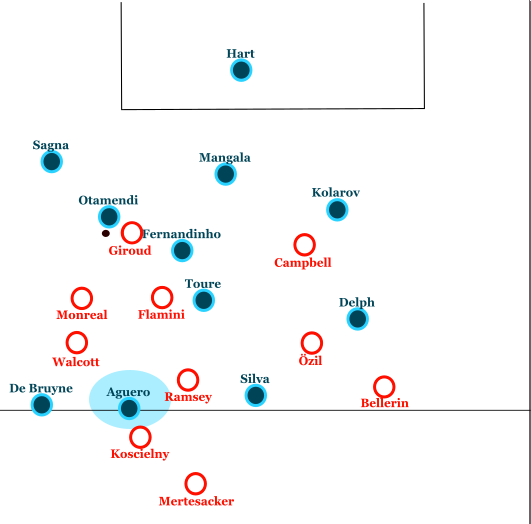
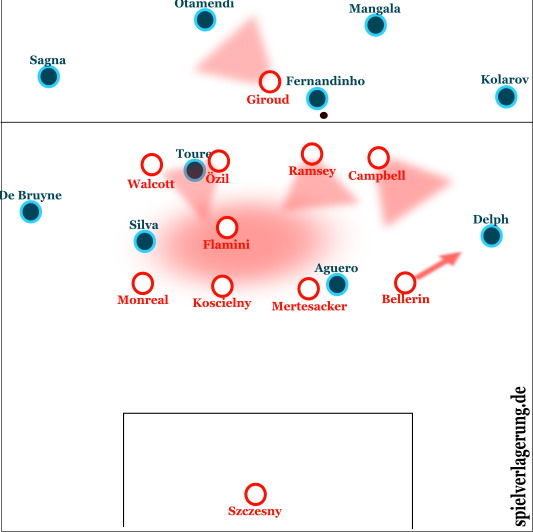
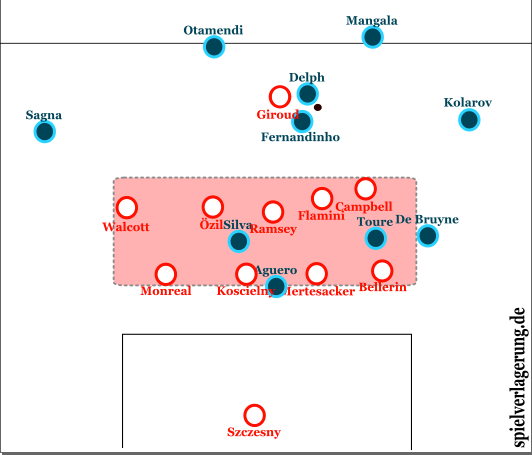


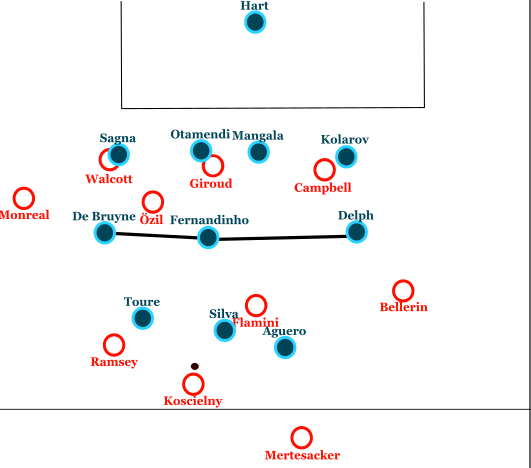
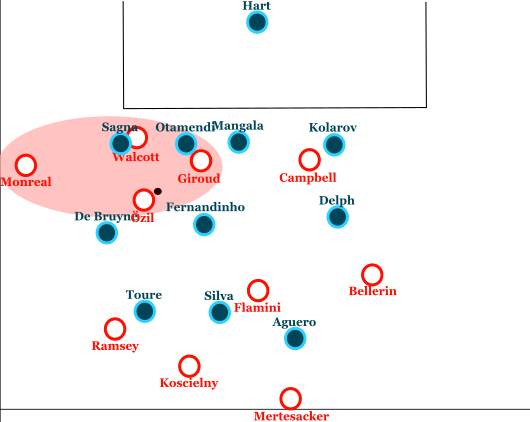
3 Kommentare Alle anzeigen
DamirO December 28, 2015 um 9:20 pm
Good read. Everything City did poorly, Southampton did well in Arsenals next match.
kathar December 24, 2015 um 12:44 am
Cech was in goal.
TT December 24, 2015 um 9:12 am
Sorry I used an old template.